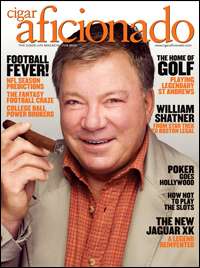Cigar Aficionado
|
Cigar Aficionado has regularly used cigar-smoking celebrities on its covers, such as this issue featuring actor William Shatner. | |
| Editor | David Savona |
|---|---|
| Total circulation (December 2014) | 256,355[1] |
| First issue | Fall 1992 |
| Company | M. Shanken Communications Inc. |
| Country | United States |
| Based in | New York City |
| Language | English |
| Website |
www |
| ISSN | 1063-7885 |
Cigar Aficionado is an American magazine that is dedicated to the world of cigars. Published since September 1992, the magazine is known for its articles about different brands of cigars worldwide, and for the celebrities that have appeared on its cover. It is also noted for its opposition to the Cuban embargo. The magazine was launched by Marvin R. Shanken's M. Shanken Communications, the publisher of Wine Spectator magazine since 1976. The current editor is David Savona.
Publication history
Origins
Cigar Aficionado magazine debuted in the fall of 1992, launched in New York City by Marvin R. Shanken, longtime publisher of Wine Spectator magazine. Prior to launching the publication, Shanken engaged in extensive market research, collecting more than 1300 four-page surveys of cigar smokers which detailed their occupation, income, net worth, travel tendencies, as well as their drinking and smoking habits.[2] Survey results revealed a well-heeled and dedicated male demographic, with survey respondents professing an average household income of $194,000 and a net worth of $1.54 million and claiming to smoke on average ten cigars per week.[2] Shanken launched a large-format glossy magazine aimed at corralling these readers and advertisers of products targeted to this audience.
Cigar Aficionado began as a lifestyle magazine, including coverage of wine, spirits, travel, gambling, and antiques, in addition to interviews with leading personalities in the cigar industry and feature articles relating to the cigarmaking industry. From the beginning the magazine emphasized interviews with celebrity cigar smokers, including cover stories on such luminaries as Rush Limbaugh,[3] Bill Cosby,[4] George Burns,[5] Jack Nicholson,[6] and Arnold Schwarzenegger.[7] The new magazine's successful blending of lifestyle reports and celebrity glitz has been credited with contributing to the 1990s cigar boom.
The publication scored its first great journalistic coup on February 4, 1994, when editor and publisher Shanken met Fidel Castro in Havana for a two-hour interview.[8] During this interview Castro recounted the story behind the establishment of the Cohiba brand, told stories of the importance of cigars to his life as a revolutionary in the mountains of Cuba, and explained his decision to give up cigar smoking in August 1986 as part of a national campaign against tobacco use.[8] In addition to these topics of special interest to cigar smokers, the interview touched upon bilateral relations between the United States and Cuba, during the course of which Castro accused the United States of repeatedly "moving the goalposts back" for ending the Cuban economic embargo and claimed that "no other country has as unblemished behavior about human rights" as Cuba.[8]
Ratings
From its inception, Cigar Aficionado has made use of blind taste testing of cigars, comparing the merits of one brand to another, expressed on the basis of a 100-point scale similar to the one successfully used in sister publication Wine Spectator.[9]
See also
References
- ↑ "eCirc for Consumer Magazines". Alliance for Audited Media. June 30, 2012. Retrieved December 30, 2012.
- 1 2 "Welcome to the Cigar Aficionado Club," Cigar Aficionado, vol. 1, no. 1 (Autumn 1992), pg. 11.
- ↑ Cigar Aficionado, Spring 1994.
- ↑ Cigar Aficionado, Autumn 1994.
- ↑ Cigar Aficionado, Winter 1994.
- ↑ Cigar Aficionado, Summer 1995.
- ↑ Cigar Aficionado, Summer 1996.
- 1 2 3 Marvin R Shanken, "A Conversation with Fidel," Cigar Aficionado, vol. 2, no. 4 (Summer 1994), pp. 46-59.
- ↑ See, for example, "Robusto Blind Tasting," Cigar Aficionado, vol. 1, no. 1 (Autumn 1992), pp. 30-35.
